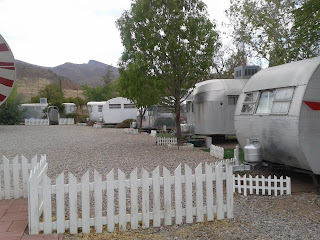Michael had the weekend off - so we decided to check out the copper mining town of Bisbee. It is pretty close to the border of Mexico. We thought we'd go see the famous wall. Here is Duncan by the wall.
Next we swang by the Shady Dell. Now this is going back in time. Pretty cool.
The Shady Dell’s long and epic journey began in 1927 as a place to provide trailer and camping spaces to weary travelers along the famous Highway 80, which stretched from Savannah, Georgia to San Diego, California. Like its more famous brother Route 66, Highway 80 was a center of travel, exploration and family getaways in the early portions of the 20th century. Today, the park is a nice mix of practicality and vintage fun-seeking. nine lovely, fully restored vintage aluminum travel trailers await you at the Shady Dell in Bisbee, Arizona. Whether it is the 33 foot Royal Mansion built in 1951 and restored with leopard carpet, martini glasses, Diner-style breakfast booth and phonograph with a collection of 78rpm records, or the 1947 Tiki Bus Polynesian Palace, complete with hand-carved outrigger bar and your own Tiki God, the Shady Dell’s individual trailers will surely send you back to a time when freedom was just another word for jumping in your aluminum house on wheels, finding the Rat Pack on the radio and navigating the open road in search of your own slice of the American Dream.
Then it was off to our main destination - the Queen Mine Tour.
Bisbee’s Queen Mine was one of the richest copper mines in history. The mine opened in 1877 and eventually closed when Phelps Dodge discontinued mining operations in Bisbee in the mid–1970’s. The Queen Mine opened once again as a tour for visitors in 1976, nearly 100 years after the mine originally opened.
Today approximately 50,000 people a year visit the Queen Mine Tour to commemorate Bisbee’s prosperous mining heritage and experience what it was like working underground where temperatures are 47 degrees year-round.
To take the tour, enter the changing house, pick up your mine token, and get outfitted with your slicker, helmet and miner’s headlamp. Board the mine train and descend into the mine. Tours are conducted by miners who worked in the mines and tell their own stories from personal experiences.
they had you wear these tags -- see Michael's shirt with the pin and tag? They said it was to count how many people came in and came out. But they had you write your name down next to a number in their book. Other bloggers suggest that it is to identify your body if the mine collapses. Comforting, eh? Below Michael's shirt is the old time tracking board.
This picture was taken down in the mine where they showed us some of the blasting equipment. Ty was really scared that they were going to use real dynamite and blow the place up. He kept plugging his ears and asking if they were really going to blow it up. He wasn't a fan of the idea. Duncan on the other hand couldn't wait for the place to blow! He kept saying things like, Cool! and When are they going to blow it up! Props to the tour guide who spoke to all of us as though we had just been hired to work in the mine. It was a fascinating living museum, so to speak.
This shows the Lavender Pit - right next to the Queen Mine. This is where they did strip mining until sometime in the late 1970's. It was really huge. Named not for the Lavender rock, but for some mining dude named Lavender.
The Lavender Pit is part of the Copper Queen Mine, run by the Phelps Dodge Corporation from 1879 to 1975. Mining took place in underground tunnels and shafts until 1951 when it was determined by Harrison Lavender, the then-manager of the Copper Queen Branch of Phelps Dodge, that an open pit mine would be an economical way to increase ore yield. The resulting Lavender Pit was mined in 50 foot benches created by loading holes drilled to a 60-foot depth with 1,200 pounds of powder charge. Blasts commonly broke 75,000 tons of rock and were usually shot at 3:25 each afternoon. Mining in the pit stopped in 1974 and all mining operation ceased in the Copper Queen Mine in 1975 when the price of copper plummeted. The abandoned pit covers 300 acres, is 950 feet deep, and is a result of the removal of 351 million tons of material. Since mining operations ceased, the town of Bisbee reinvented itself as an artist community and historical tourist destination. During this reinvention, the Lavender Pit became a tourist destination with rim viewing platforms and guided tours.
Lastly, on our way out of town - had to take a picture at Choppers! They even have their own facebook page: https://www.facebook.com/pages/Fast-Lane-Choppers-Cochise-County/299878280068088
Amazing that these places are still around. Have to say that our first adventure in SouthEast Arizona was a success.
















Kristi this looks like it was so much fun!
ReplyDelete